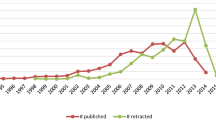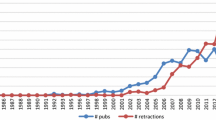Abstract
Scientific advancement is driven by new discoveries that often build upon previous knowledge - usually in good faith. Yet recently, there is an increasing number of either erroneous publications or even cases of scientific misconduct, as evidenced by rapidly growing numbers of retracted articles. Unfortunately, the problem is not only limited to retracted articles, but also with all articles citing them. Whenever an article is retracted, it raises concerns about the validity of its findings, rendering it an unreliable source for subsequent citations. Consequently, all articles citing a retracted article come under scrutiny. However, Re-evaluating all citing articles is a tedious, unrealistic, and unnecessary process because not all citations hold equal significance. Therefore, we aim to identify citation patterns that lead to cascading retractions. We investigate around 5000 articles citing retracted articles, including 953 cases of cascading retractions. Moreover, we propose a retraction-centric approach to rank articles that are close to retraction by measuring their similarities to bibliographically coupled retracted articles. This study presents an alternative to exhaustive re-examination, offering a more efficient means to scrutinize the articles that require re-evaluation.
Access this chapter
Tax calculation will be finalised at checkout
Purchases are for personal use only
Similar content being viewed by others
Notes
- 1.
- 2.
- 3.
- 4.
- 5.
- 6.
The articles listed in Table 3 are identified based on textual similarity and citation analysis. This does not imply any subjective review of the content or validity of the articles. The authors do not claim that the listed articles are definitively flawed. Instead, this analysis aims to highlight potential areas for further investigation.
References
Addepalli, A., Subin, K.A., Schneider, J.: Testing the keystone framework by analyzing positive citations to Wakefield’s 1998 Paper. In: Smits, M. (ed.) Information for a Better World: Shaping the Global Future. iConference 2022, vol. 13192, pp. 79–88. Springer, Cham (2022). https://doi.org/10.1007/978-3-030-96957-8_9
Aljuaid, H., Iftikhar, R., Ahmad, S., Asif, M., Afzal, M.T.: Important citation identification using sentiment analysis of in-text citations. Telematics Inform. 56, 101492 (2021). https://doi.org/10.1016/j.tele.2020.101492
Bar-Ilan, J., Halevi, G.: Post retraction citations in context: a case study. Scientometrics 113(1), 547–565 (2017). https://doi.org/10.1007/s11948-015-9680-y
Bolland, M.J., Grey, A., Avenell, A.: Citation of retracted publications: a challenging problem. Accountability Res. 29(1), 18–25 (2022). https://doi.org/10.1080/08989621.2021.1886933
Candal-Pedreira, C., Ruano-Ravina, A., Fernández, E., Ramos, J., Campos-Varela, I., Pérez-Ríos, M.: Does retraction after misconduct have an impact on citations? a pre-post study. BMJ Glob. Health 5(11), e003719 (2020). https://doi.org/10.1136/bmjgh-2020-003719
Ciancarini, P., Di Iorio, A., Nuzzolese, A.G., Peroni, S., Vitali, F.: Evaluating citation functions in CiTO: cognitive issues. In: Presutti, V., d’Amato, C., Gandon, F., d’Aquin, M., Staab, S., Tordai, A. (eds.) ESWC 2014. LNCS, vol. 8465, pp. 580–594. Springer, Cham (2014). https://doi.org/10.1007/978-3-319-07443-6_39
Cohan, A., Feldman, S., Beltagy, I., Downey, D., Weld, D.S.: SPECTER: document-level representation learning using citation-informed transformers. arXiv preprint arXiv:2004.07180 (2020)
Dubois, J.M., et al.: Understanding research misconduct: a comparative analysis of 120 cases of professional wrongdoing. Accountability Res. 20(5-6), 320–338 (2013). https://doi.org/10.1080/08989621.2013.822248
Fang, F.C., Steen, R.G., Casadevall, A.: Misconduct accounts for the majority of retracted scientific publications. Proc. Natl. Acad. Sci. 109(42), 17028–17033 (2012). https://doi.org/10.1073/pnas.1212247109
Feng, L., Yuan, J., Yang, L.: An observation framework for retracted publications in multiple dimensions. Scientometrics 125(2), 1445–1457 (2020). https://doi.org/10.1007/s11192-020-03702-3
Fu, Y., Schneider, J.: Towards knowledge maintenance in scientific digital libraries with the keystone framework. In: Proceedings of the ACM/IEEE Joint Conference on Digital Libraries in 2020, pp. 217–226 (2020). https://doi.org/10.1145/3383583.3398514
Fu, Y., Schneider, J., Blake, C.: Finding keystone citations for constructing validity chains among research papers. In: Companion Proceedings of the Web Conference 2021, pp. 451–455 (2021). https://doi.org/10.1145/3442442.3451368
Guo, Z., Schlichtkrull, M., Vlachos, A.: A survey on automated fact-checking. Trans. Assoc. Comput. Linguist. 10, 178–206 (2022). https://doi.org/10.1162/tacl_a_00454
Handley-Miner, I.J., et al.: The intentions of information sources can affect what information people think qualifies as true. Sci. Rep. 13(1), 7718 (2023). https://doi.org/10.1038/s41598-023-34806-4
Hassan, S.U., Akram, A., Haddawy, P.: Identifying important citations using contextual information from full text. In: 2017 ACM/IEEE Joint Conference on Digital Libraries (JCDL), pp. 1–8. IEEE (2017). https://doi.org/10.1109/JCDL.2017.7991558
Hinz, M., Stein, A., Cole, T.: RETRACTED ARTICLE: management of L-dopa overdose in the competitive inhibition state. Drug Healthc. Patient Saf. 6, 93–99 (2014). https://doi.org/10.2147/DHPS.S67328
Hinz, M., Stein, A., Cole, T.: Management of L-dopa overdose in the competitive inhibition state. Drug Healthc. Patient Saf. 12, 271–272 (2020). https://doi.org/10.2147/DHPS.S296332
Hinz, M., Stein, A., Cole, T., McDougall, B., Westaway, M.: Retracted article: Parkinson’s disease managing reversible neurodegeneration. Neuropsychiatric Dis. Treat. 12, 763–775 (2016). https://doi.org/10.2147/NDT.S98367
Hinz, M., Stein, A., Cole, T., McDougall, B., Westaway, M.: Parkinson’s disease managing reversible neurodegeneration. Neuropsychiatr. Dis. Treat. 16, 3125–3126 (2020). https://doi.org/10.2147/NDT.S296333
Hsiao, T.K., Torvik, V.I.: OpCitance: citation contexts identified from the PubMed central open access articles. Sci. Data 10(1), 243 (2023). https://doi.org/10.1038/s41597-023-02134-x
Keiser, M.J., et al.: Predicting new molecular targets for known drugs. Nature 462(7270), 175–181 (2009). https://doi.org/10.1038/nature08506
Kühberger, A., Streit, D., Scherndl, T.: Self-correction in science: the effect of retraction on the frequency of citations. PLoS ONE 17(12), e0277814 (2022). https://doi.org/10.1371/journal.pone.0277814
Li, M., Shen, Z.: Science map of academic misconduct. Innovation 5(2), 100593 (2024). https://doi.org/10.1016/j.xinn.2024.100593
Qayyum, F., Afzal, M.T.: Identification of important citations by exploiting research articles’ metadata and cue-terms from content. Scientometrics 118, 21–43 (2019). https://doi.org/10.1007/s11192-018-2961-x
Schneider, J., Ye, D., Hill, A.M., Whitehorn, A.S.: Continued post-retraction citation of a fraudulent clinical trial report, 11 years after it was retracted for falsifying data. Scientometrics 125, 2877–2913 (2020). https://doi.org/10.1007/s11192-020-03631-1
Sharma, K.: Team size and retracted citations reveal the patterns of retractions from 1981 to 2020. Scientometrics 126(10), 8363–8374 (2021). https://doi.org/10.1007/s11192-021-04125-4
Shema, H., Hahn, O., Mazarakis, A., Peters, I.: Retractions from altmetric and bibliometric perspectives. Inf. Wiss. Prax. 70(2–3), 98–110 (2019). https://doi.org/10.1515/iwp-2019-2006
Smith, R.: Investigating the previous studies of a fraudulent author. BMJ 331(7511), 288–291 (2005). https://doi.org/10.1136/bmj.331.7511.288
Sudhakar, A., et al.: Human \(\alpha \)1 type IV collagen NC1 domain exhibits distinct antiangiogenic activity mediated by \(\alpha \)1\(\beta \)1 integrin. J. Clin. Investig. 115(10), 2801–2810 (2005). https://doi.org/10.1172/JCI24813
Sudhakar, A., et al.: Human \(\alpha \)1 type IV collagen NC1 domain exhibits distinct antiangiogenic activity mediated by \(\alpha \)1\(\beta \)1 integrin. J. Clin. Invest. 130(1), 552 (2020). https://doi.org/10.1172/JCI135305
Te, S., Barhoumi, A., Lentschat, M., Bordignon, F., Labbé, C., Portet, F.: Citation context classification: critical vs non-critical. In: Proceedings of the Third Workshop on Scholarly Document Processing, pp. 49–53 (2022)
Thelwall, M.: Should citations be counted separately from each originating section? J. Informet. 13(2), 658–678 (2019). https://doi.org/10.1016/j.joi.2019.03.009
Usman, M., Balke, W.T.: On retraction cascade? Citation intention analysis as a quality control mechanism in digital libraries. In: Alonso, O., Cousijn, H., Silvello, G., Marrero, M., Teixeira Lopes, C., Marchesin, S. (eds.) Linking Theory and Practice of Digital Libraries, pp. 117–131. Springer, Cham (2023). https://doi.org/10.1007/978-3-031-43849-3_11
Wakefield, A.J., et al.: RETRACTED: ileal-lymphoid-nodular hyperplasia, non-specific colitis, and pervasive developmental disorder in children. Lancet 351(9103), 637–641 (1998). https://doi.org/10.1016/S0140-6736(97)11096-0
Wan, X., Liu, F.: Are all literature citations equally important? Automatic citation strength estimation and its applications. J. Am. Soc. Inf. Sci. 65(9), 1929–1938 (2014). https://doi.org/10.1002/asi.23083
Wang, M., Zhang, J., Jiao, S., Zhang, X., Zhu, N., Chen, G.: Important citation identification by exploiting the syntactic and contextual information of citations. Scientometrics 125, 2109–2129 (2020). https://doi.org/10.1007/s1192-020-03677-1
Williams, P., Wager, E.: Exploring why and how journal editors retract articles: findings from a qualitative study. Sci. Eng. Ethics 19(1), 1–11 (2013). https://doi.org/10.1007/s11948-011-9292-0
Zhang, C., Ding, K., Liu, Z.: Informetric analysis on the international retracted publication based on the web of science database. In: 5th Annual International Conference on Social Science and Contemporary Humanity Development (SSCHD 2019), pp. 472–481. Atlantis Press (2019). https://doi.org/10.2991/sschd-19.2019.100
Acknowledgments
This work was supported by the Deutsche Forschungsgemeinschaft (DFG, German Research Foundation) under Grant No. Gepris 267140244 for the PubPharm - Specialized Information Service for Pharmacy.
Author information
Authors and Affiliations
Corresponding author
Editor information
Editors and Affiliations
Rights and permissions
Copyright information
© 2024 The Author(s), under exclusive license to Springer Nature Switzerland AG
About this paper
Cite this paper
Usman, M., Balke, WT. (2024). Tracing the Retraction Cascade: Identifying Non-retracted but Potentially Retractable Articles. In: Antonacopoulos, A., et al. Linking Theory and Practice of Digital Libraries. TPDL 2024. Lecture Notes in Computer Science, vol 15177. Springer, Cham. https://doi.org/10.1007/978-3-031-72437-4_7
Download citation
DOI: https://doi.org/10.1007/978-3-031-72437-4_7
Published:
Publisher Name: Springer, Cham
Print ISBN: 978-3-031-72436-7
Online ISBN: 978-3-031-72437-4
eBook Packages: Computer ScienceComputer Science (R0)




